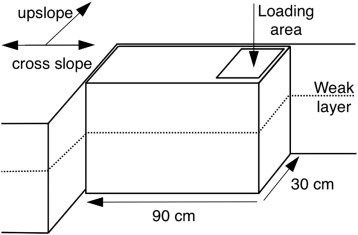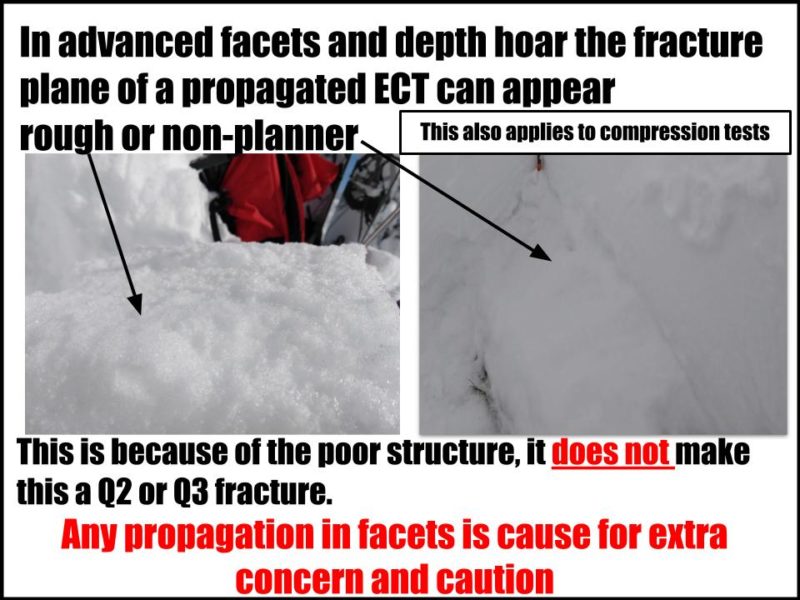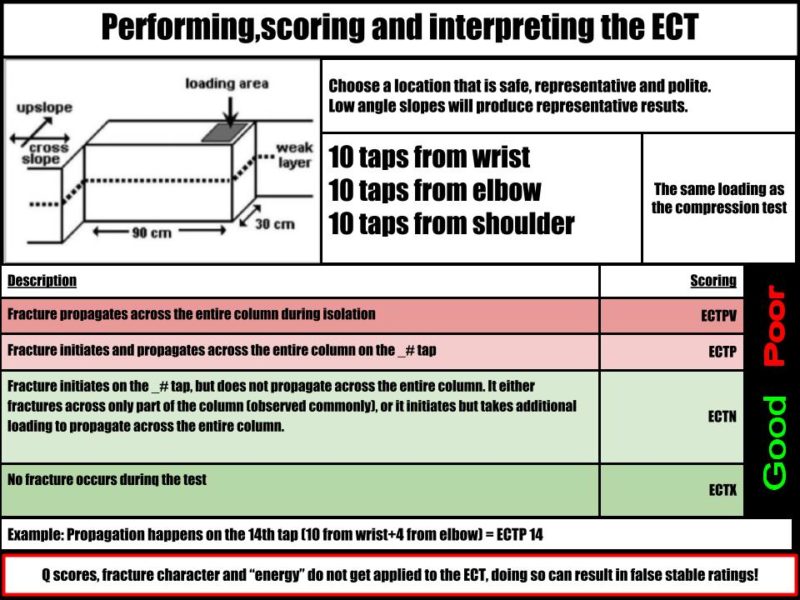
If I am going to do just one test, I do an extended column test (ECT). It gives me some information on the strength of a weak layer, but most importantly, the likelihood of propagation.
It is a simple test. A column 30cm (12”) by 90cm (36”) is isolated. Taps are applied from the wrist, elbow, and shoulder.
This video demonstrates it well.
The most pertinent information in the extended column test is:
- Did it propagate or not?
Propagation in the extended column test (ECT) is the best indicator of instability. When there is propagation, take it as a warning. Do not try to downgrade it with the addition of a sheer quality score.
Extended column tests do not get quality scores (Q)
Q scores were removed from the ECT in 2016. See this announcement.
Why?:
- Q scores are used in the compression test (CT) to predict propagation. The extended column test (ECT) tests for propagation so a predictor is unnecessary.
- Use of Q scores with the ECT can lead to assessing the snowpack as more stable than it is. A dangerous mistake to make.
Shear quality (Q) is often derived from block movement, and this is dependent on the friction at the fracture plane and the slope angle. On steep enough slopes, almost all propagated ECTs will slide off the column. On lower angle slopes, <35º, the block may not slide off, but this is not a reflection of Q score, the amount of “energy” in the block, or the likelihood of an avalanche. “Energy” is not part of the ECT assessment. The interpretation of both Q score and energy can be subjective, varies from person to person, and should not be used to assess stability with the ECT.
Propagation in large facets and depth hoar may appear non-planner, but this does not make them Q2 or Q3. Propagation in facets, regardless of how the shear plane appears, is a flashing red light.
ECT tells us if the structure exists for propagation to spread horizontally under a slab. When propagation happens, it delaminates the slab from the bed surface. If the slope is steep enough to overcome the friction between the slab and bed surface, there will be an avalanche.
When we have propagation, interpret it as a Q2 or Q3, and decide to ski the slope as a result, we are gambling on friction holding a delaminated slab to a bed surface.
Applying Q scores to ECT is an example of “trying to outsmart the problem layer,” whether wittingly or not.

Structure:
Certain snowpack structures are more likely to avalanche than others. The structure can be measured and is more objective than interpretations of energy. We can use some basic rules to assess the structure at the failure plane in our ECT.
- The weak layer is within the top meter (40”) of the snowpack
- The problem layer is less than 4” thick
- There is an obvious hardness step at the problem layer. For instance soft snow under a crust, or stiff snow over lighter.
- There are faceted crystals at the fracture. Obvious sugary snow, or surface hoar.
- There is a visible size difference in crystals at and above or below the fracture plane. You don’t need a lens to see this you should be able to ID this by looking carefully.
When three or more of these are present, we have a higher likelihood of triggering an avalanche.
When you have propagation, and poor structure, stay off avalanche slopes regardless of the strength, number of taps, or perceived energy.
Where to dig?
When we assess the snowpack with an ECT, we want our location to be:
- Safe
- Representative
- Polite
This means digging at the same elevation and aspect that you want to ski or ride, and not in the middle of the best line.
Remember that small changes in aspect in elevation can mean big changes in the snowpack. Be picky about your location, and be sure it matches the characteristics of your intended run.
The ECT gives us representative results on low angle slopes. This means we can choose safe slopes well under 30º to dig on.
Limitations of the ECT
While the ECT is my go-to test, it does have some limitations, and these are important to understand for making informed decisions regarding snow stability. The key points are:
- Shallow, soft slabs may not show propagation in the ECT because they lack the stiffness to transmit the propagation.
- The ECT can affect layers down to 120cm (4’). However, the effectiveness is diminished by as much as 70% below 70cm, (2’4″).
- The ECT has a portion of its results that are false stable, meaning you may not see propagation despite poor stability. This is why multiple tests are better than a single one.
The last two points are why the structure is so important. The structure is a warning sign and can guide you for what to look for and expect in pits. If poor structure exists, and there was a failure in a compression test, be very suspicious of ECTs that do not fail on that layer.
– Jeff Carty
Avalanche Forecaster
West Central Montana Avalanche Center

References
Birkeland, K. W. (2004). Comments on using shear quality and fracture character to improve stability test interpretation. The Avalanche Review, 23(2), 13.
Birkeland, K. W., Bair, E., & Chabot, D. (2014). The effect of changing slope angle on compression test results. In Proceedings of the International Snow Science Workshop 2014, Banff, Alberta (pp. 746-751).
Greene, E., Birkeland, K. W., Elder, K., Johnson, G., Landry, C., McCammon, I., … & Williams, K. (2004). Snow, weather, and avalanches: Observational guidelines for avalanche programs in the United States. American Avalanche Association, Pagosa Springs, Colorado, 150.
Guyn, T. 10 COMMON MISSTEPS OF AVALANCHE PRACTITIONERS INTERNATIONAL SNOW SCIENCE WORKSHOP 2016 IN BRECKENRIDGE, CO.
McCammon, I., & Schweizer, J. (2002, October). A field method for identifying structural weaknesses in the snowpack. In Proceedings ISSW (pp. 477-481).
Ross, C., & Jamieson, B. (2008, September). Comparing fracture propagation tests and relating test results to snowpack characteristics. In Proceedings ISSW (pp. 376-385).
van Herwijnen, A., & Jamieson, B. (2007). Fracture character in compression tests. Cold Regions Science and Technology, 47(1-2), 60-68.















